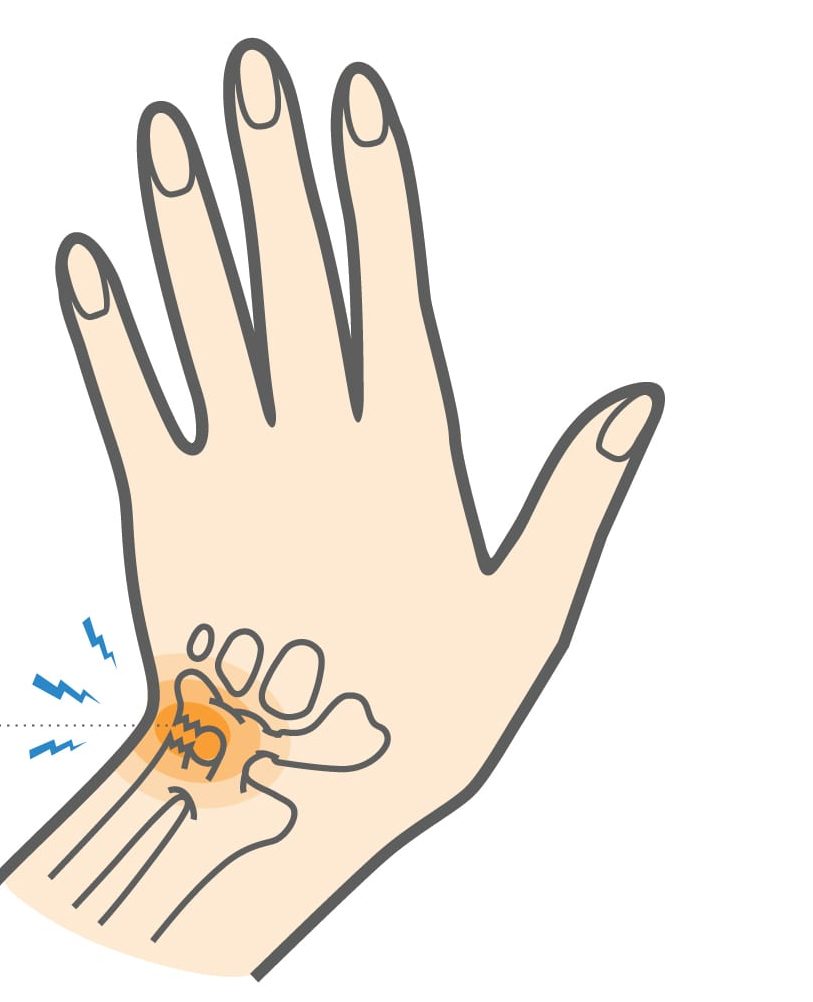The wrist performs a complicated set of functions. It rotates and moves forward, backwards, and side to side, all while providing a strong connection between the forearm and the hand. The Triangular Fibrocartilage Complex (TFCC) helps give the wrist these abilities. Located between the radius and the ulna, the two bones of the forearm, the TFCC is a group of ligaments and cartilage that connect the forearm bones with the carpal bones of the wrist. The TFCC can tear due to overuse, an acute injury, or chronic breakdown of the tissues. The severity of a TFCC injury can range widely.
Triangular Fibrocartilage Complex (TFCC) Tear Treatment
The wrist performs a complicated set of functions. It rotates and moves forward, backward, and side to side while providing a strong connection between the forearm and the hand. The Triangular Fibrocartilage Complex (TFCC) helps give the wrist these abilities. Located between the radius and the ulna, the two bones of the forearm, the TFCC is a group of ligaments and wrist cartilage that connect the forearm bones with the wrist's carpal bones. A TFCC injury can occur due to overuse, an acute injury, or a chronic breakdown of the tissues. The severity of a TFCC injury can range widely, often leading to ulnar-sided wrist pain, wrist instability, and pain rotating your hand.
Overview
Overview

What causes Triangular Fibrocartilage Complex (TFCC) Tear?
Triangular fibrocartilage complex tears are common among athletes, particularly those who perform activities that can overuse and stress the wrist, such as gripping or swinging a baseball bat, racket, or club. TFCC tears can also occur due to a traumatic injury to the wrist, such as a fall. Another contributing factor can be age, due the breakdown of the ligaments in the wrist over time.
TFCC tears are most common in these sports:
• Baseball
• Racket Sports (e.g. tennis, racket ball, squash)
• Golf
• Hockey
Symptoms
People with triangular fibrocartilage complex tears usually experience pain in their wrist, often towards the ulnar side (pinky finger side) of the wrist. The pain may be constant, or only felt during activity. Other common symptoms of TFCC tears include:
• Weakness when trying to pick up or hold objects
• Tenderness to touch the ulnar side of the wrist
• Swelling
• Limited range of motion
• Popping or clicking sound that may be present when moving wrist
When to see a doctor
You should see your doctor if you have symptoms of a TFCC tear or wrist cartilage tear. To make the diagnosis, your doctor will ask about your injury and the sports you play, and conduct a physical examination to look for signs of injury. If a tear is suspected, your doctor may apply pressure to areas of your wrist and ask you to move it into various positions. Imaging tests, such as X-rays and magnetic resonance imaging (MRI), may be ordered to look at the bones and soft tissues in your wrist. These tests help confirm the diagnosis and rule out other causes of your ulnar-sided wrist pain or wrist instability.
Non-operative treatment
Treatment of TFCC tears depend upon the severity and location of the tear and whether there is any associated instability of the joint. The vast majority of TFCC tears can be treated non-operatively. Conservative treatment typically involves:
• Rest from activity that places stress on the wrist
• Ice
• Nonsteroidal anti-inflammatory drugs (NSAIDs), such as ibuprofen and naproxen, for pain relief
• Wearing a splint or cast for several weeks to • Immobilize the wrist
• If needed, a cortisone (anti-inflammatory medication) injection for pain
• Physical therapy after the TFCC heals
Try these exercises to help address your condition:
Below is a PDF of the exercise program.
Surgical Treatment
If your TFCC is severely torn, the wrist is unstable, or pain persists after conservative treatment, your doctor may suggest surgery. Surgery is often conducted through a minimally invasive procedure called arthroscopy, in which only small incisions are made. By looking inside the wrist with a tiny camera for guidance, your surgeon can repair the torn ligaments or remove damaged tissue (called debridement). It’s important to discuss with your surgeon the risks and benefits of a surgical procedure.
Recovery
Recovery from a TFCC tear without surgery can take four to six weeks, and considerably longer after surgery. Most athletes can expect a full return to play after a rehabilitation period that includes physical therapy to regain motion and build back strength.
GET BACK TO WHAT YOU LOVE. FASTER
Frequently Asked Questions
What causes a wrist cartilage tear?
A wrist cartilage tear can result from repetitive stress, falls, forceful twisting, or age-related degeneration. Athletes and workers who use frequent wrist motions are more susceptible.
How do I know if I have a TFCC injury?
Symptoms include ulnar-sided wrist pain, clicking or popping during movement, wrist instability, and pain rotating the hand, for example when turning a doorknob or opening a can.
Is a TFCC injury permanent?
Usually not. . With timely treatment, whether conservative or surgical, many people recover fully; however, untreated tears can lead to chronic wrist instability and loss of function.
When should I see a doctor for ulnar-sided wrist pain?
If you experience persistent pain on the pinky side of your wrist, especially with moving your wrist or rotating your hand, consult a specialist to check for a TFCC tear or wrist cartilage tear.

